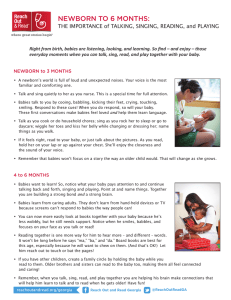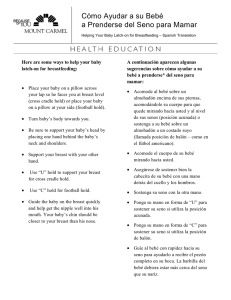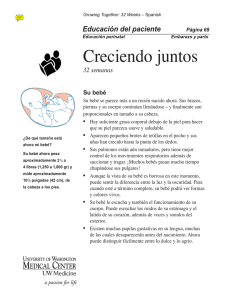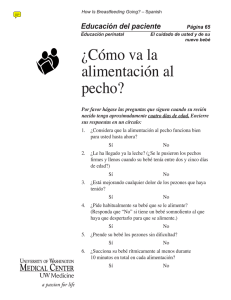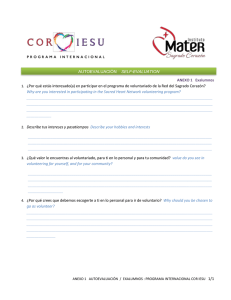Preocupaciones comunes acerca de la alimentación
Anuncio
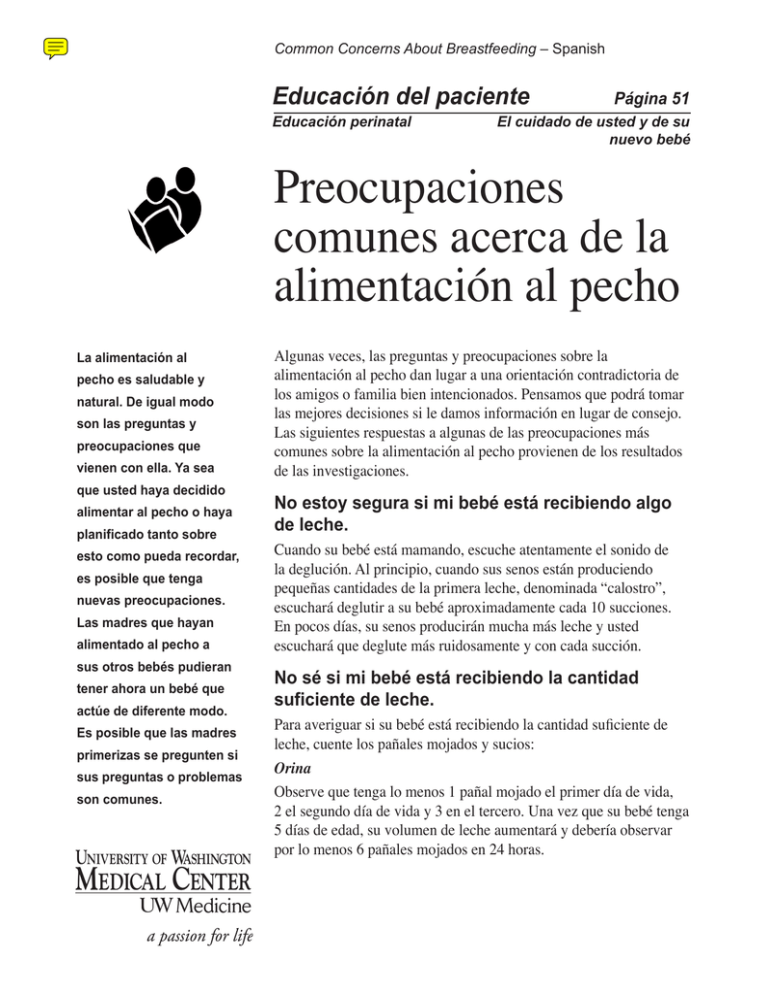
Common Concerns About Breastfeeding – Spanish Educación del paciente Educación perinatal Página 51 El cuidado de usted y de su nuevo bebé Preocupaciones comunes acerca de la alimentación al pecho La alimentación al pecho es saludable y natural. De igual modo son las preguntas y preocupaciones que vienen con ella. Ya sea que usted haya decidido alimentar al pecho o haya planificado tanto sobre esto como pueda recordar, es posible que tenga nuevas preocupaciones. Las madres que hayan alimentado al pecho a sus otros bebés pudieran tener ahora un bebé que actúe de diferente modo. Es posible que las madres primerizas se pregunten si sus preguntas o problemas son comunes. Algunas veces, las preguntas y preocupaciones sobre la alimentación al pecho dan lugar a una orientación contradictoria de los amigos o familia bien intencionados. Pensamos que podrá tomar las mejores decisiones si le damos información en lugar de consejo. Las siguientes respuestas a algunas de las preocupaciones más comunes sobre la alimentación al pecho provienen de los resultados de las investigaciones. No estoy segura si mi bebé está recibiendo algo de leche. Cuando su bebé está mamando, escuche atentamente el sonido de la deglución. Al principio, cuando sus senos están produciendo pequeñas cantidades de la primera leche, denominada “calostro”, escuchará deglutir a su bebé aproximadamente cada 10 succiones. En pocos días, su senos producirán mucha más leche y usted escuchará que deglute más ruidosamente y con cada succión. No sé si mi bebé está recibiendo la cantidad suficiente de leche. Para averiguar si su bebé está recibiendo la cantidad suficiente de leche, cuente los pañales mojados y sucios: Orina Observe que tenga lo menos 1 pañal mojado el primer día de vida, 2 el segundo día de vida y 3 en el tercero. Una vez que su bebé tenga 5 días de edad, su volumen de leche aumentará y debería observar por lo menos 6 pañales mojados en 24 horas. Página 52 Educación perinatal ¡“Esta es una experiencia gratificante. Divertida, FÁCIL y GRATUITA! Es también el mejor alimento que su bebé puede recibir”. “Justamente cuando estaba empezando a preguntarme si mi bebé estaba comiendo lo suficiente, llegó mi leche. Luego él menudo dormía un poco más después de que comía y pude darme cuenta de que realmente estaba recibiendo mi leche”. El cuidado de usted y de su nuevo bebé Preocupaciones comunes acerca de la alimentación al pecho Evacuaciones intestinales Durante los primeros días, debería haber al menos 1 a 2 evacuaciones intestinales cada día. Comenzarán oscuras y pegajosas y se volverán parduscas y blandas. Una vez que su bebé tenga 5 días de edad, debería observar al menos 4 pañales sucios en 24 horas. La mayoría de las veces, las evacuaciones intestinales de un bebé alimentado al pecho tienen un aspecto amarillo mostaza. Algunos bebés comienzan a tener mucho menos evacuaciones intestinales después del primer mes de vida. Asegúrese de llevar a su bebé a aquellas primeras visitas de seguimiento para las revisiones del peso. El peso de su bebé es el factor clave que nos indica que está recibiendo el suficiente alimento. Mi bebé está todavía quisquilloso o llorando, aún después de ser alimentado al pecho. Con frecuencia los bebés tienen momentos de estar quisquillosos. Algunas veces necesitan eructar o simplemente que se los reconforte. Sin embargo, durante los primeros días, algunos bebés necesitan mamar con mucha frecuencia e incluso tener algunas “alimentaciones prolongadas”, cuando parecen estar despiertos durante un par de horas y lactan mucho durante ese tiempo. Frecuentemente, su bebé dormirá después de una alimentación prolongada. Los estudios demuestran que las madres tienen un mejor suministro de leche y menos dilatación de los senos cuando sus bebés lactan más de 8 veces al día. Sus bebés suben mejor de peso y tienen menos ictericia que los que se alimentan con menor frecuencia. Es posible que el llanto aumente aproximadamente a las 4 a 6 semanas de edad. Todos los bebés, ya sea que se alimenten al pecho o con biberón, pasan aproximadamente 2 horas al día en un estado quisquilloso o llorando. Esto no significa que algo esté mal y es muy normal. No espere una rutina predecible hasta después de los 4 meses. Revise los pañales de su bebé como se indicó anteriormente, para asegurarse de que esté recibiendo lo suficiente para comer. No sé cuánto tiempo debería tomar cada alimentación. Los bebés le dejan saber que han terminado una alimentación al disminuir su succión y deglución. El cuerpo de su bebé llegará a estar lánguido y relajado. Las investigaciones muestran que es mejor no Página 53 El cuidado de usted y de su nuevo bebé Preocupaciones comunes acerca de la alimentación al pecho interrumpir la alimentación del primer lado simplemente para que reciba del otro lado durante cada alimentación. Cuando su bebé acabe con el primer seno, puede soltar su pezón y quedarse dormido. O bien, si desea el otro lado, abrirá su boca como si buscara el pezón. Puede hacerle eructar primero y luego ofrecerle el otro lado. Una alimentación normalmente dura aproximadamente 20 a 45 minutos. Algunas alimentaciones son más rápidas y algunas son más lentas que esto. Los primeros días, es normal que su bebé reciba pequeñas cantidades de calostro y permanecer en el seno durante períodos de tiempo prolongados puede ayudar a que se sienta satisfecho. Si su bebé está tomando y sujetando bien su seno, las sesiones prolongadas de alimentación no hacen que se irriten los pezones. Evite el dolor del pezón con una sujeción cuidadosa, no con límites en el tiempo de alimentación. Educación perinatal “Lo que más me sorprendió es la frecuencia con que los nuevos bebés necesitan ser alimentados. Pensé que cada 3 horas del día y de la noche era increíble, pero estaba totalmente impresionada cuando pedía MÁS alimentaciones después de poco tiempo…” “Lo más útil fue la ayuda práctica de la enfermera”. “Tenía una amiga que me ¿Cuándo debería cambiar al otro lado? visitó un mes después de Como se indicó anteriormente, deje que su bebé marque la pauta sobre esto. Si su bebé está satisfecho, esta bien que lacte de un seno en cada alimentación. La leche que su bebé recibe después de varios minutos de alimentación de uno de los senos (hindmilk) tendrá un mayor contenido de grasa que la leche al comienzo de la alimentación. Esto contribuye a una leche bien balanceada. Simplemente comience la siguiente alimentación en el otro seno. que tuve al bebé, cuando ¿Con cuánta frecuencia debería alimentar al pecho a mi bebé? ella estaba totalmente en lo Los primeros días, algunos bebés parecen estar despiertos y comiendo la mayoría del tiempo y otros duermen completamente durante las alimentaciones que necesitan. La primera semana, dé aproximadamente el pecho al menos cada 3 horas durante el día, cuando usted está despierta – o más pronto si su bebé actúa como si estuviera hambriento. Si aún está dormido después de 3 horas del comienzo de la última alimentación, desvístalo y cámbiele su pañal. Si no despierta, déjelo dormir durante otros 15 a 25 minutos, sin embargo observe los signos de hambre (movimientos de la boca, succiones, llevarse las manos a la boca). Será más fácil alimentarlo cuando usted observe estas señales a que trate de despertarlo de un sueño profundo. Una buena pauta para tener en cuenta es al menos 8 alimentaciones en un período de 24 horas. pensaba que la lactancia estaba mejorando. Y me dijo que, parece descabellado, pero va a ponerse aún más fácil en un par de meses, y correcto”. Página 54 Educación perinatal “Tuvimos varias noches de intentar resolver la sujeción apropiada del pezón. Él se frustró y luego dejó de intentarlo. Mi consejo es que siga adelante”. “Deseo que alguien me hubiera dicho que esto puede requerir trabajo. Aunque daba la impresión de ser natural – tomó trabajo lograr una rutina para que ambos aprendamos cómo amamantar correctamente”. “…. El amor es lo más importante que podría darle a mi bebé”. El cuidado de usted y de su nuevo bebé Preocupaciones comunes acerca de la alimentación al pecho A medida que su bebé crezca, será más fácil determinar cuándo necesita comer y usted puede depender de él y no del reloj para decidir cuándo es el momento de alimentar. No puedo darme cuenta si mi bebé está tomando y sujetando bien mi seno. Lo mejor es colocar a su bebé en su pecho, sin manta. Quítele la manta y la ropa de la cintura para arriba. Sosténgalo junto a usted – “estómago contra estómago” – con todo su cuerpo girado hacia usted. Cuando su cuerpo esté alineado frente a usted entonces podrá tragar fácilmente y no tendrá que girar su cabeza para lactar. Deje que su cabeza se incline un poquito hacia atrás, coloque su pezón frente a su nariz. Exprima una pequeña gota de calostro o leche para ayudarle a que preste atención. Luego, espere a que abra completamente la boca con la lengua hacia delante. Solamente cuando vea esa boca completamente abierta debe usted llevarlo rápidamente a su seno. Sus labios deben estar curvados hacia afuera, alrededor de su areola (la parte oscura alrededor del pezón). Más que simplemente el pezón debería estar en su boca. Su barbilla (mentón) y su nariz deben tocar su seno. Si la succión es dolorosa después de contar lentamente hasta 10, entonces use su dedo para interrumpir la succión y comience de nuevo. Algunos bebés tienen que aprender a succionar de la manera correcta, pero la mayoría de las veces lo practican correctamente, lo mejor que pueden hacerlo. Dejar que su bebé succione de cierto modo que sea doloroso para usted no es bueno ni para usted ni para el bebé. Pida ayuda si está teniendo dificultad. Mi bebé no se queda tomando y sujetando el seno. Nuevamente, algunos bebés tienen que aprender a succionar de la manera correcta. Y, usted puede ayudar. Los primeros uno o dos días, es posible que usted tenga que ayudar a que su bebé vuelva a sujetar el pezón varias veces hasta que parezca funcionar. A veces un bebé parecerá estar correctamente sujetado, pero si se sale fácilmente, pudiera ser que para empezar no haya entrado lo suficiente del seno en su boca. Después de algunos días, la mayoría de los bebés han entendido y usted no tendrá que prestar tal atención cuidadosa a la sujeción del seno. (Véase Posición y sujeción del seno para la alimentación al pecho, páginas 41 a 48 en este folleto). Página 55 El cuidado de usted y de su nuevo bebé Preocupaciones comunes acerca de la alimentación al pecho Mi bebé quiere quedarse sujetando el seno todo el día. Educación perinatal “No permita que nadie Los primeros días, es normal y saludable tener a su bebé en los brazos y en su seno la mayor parte del tiempo. Esto estimula las alimentaciones frecuentes, ayuda a mantener a su bebé caliente y seguro y ayuda a que llegue su leche. Hasta aproximadamente el cuarto día, la cantidad de leche habrá aumentado y probablemente su bebé tendrá momentos de sueño más largos entre las alimentaciones. Los estudios han demostrado que ofrecer pacificadores (chupones) los primeros días conduce a problemas en la alimentación al pecho. Si su bebé quiere succionar, debería darle el pecho. Esto ayuda a que se produzca su leche y estimula la succión correcta en el seno. Conforme pasen las semanas, podrá encontrar que dar un pacificador a su bebé de vez en cuando no causa problemas con la alimentación. le desaliente de hacer lo Mis pezones están doloridos. me ayudó a afrontar el tener Un poco de sensibilidad los primeros días puede ser normal. Con frecuencia, los primeros segundos después de que el bebé toma y sujeta el pezón se siente dolor. Luego, a medida que su bebé entra en el ritmo de succionar, sentirá un tirón intenso, sin embargo esto no debería causar dolor. Después de algunos días, llegará su leche y eso casi siempre mejora la sensibilidad. que llevarlo a la guardería”. Si el dolor no parece una molestia normal, no mejora bastante cuando llega la leche o, si ve su piel dañada, llame al Especialista en Lactancia. Si tiene dolor en los senos y fiebre, llame a su médico o matrona. Véase Dolor en los pezones, páginas 49 a 50 en este folleto. Mis senos están doloridos. La dilatación de los senos normal ocurre normalmente el segundo, tercer o cuarto día después del parto. Esta es una señal de que su leche está llegando. Véase Medidas de bienestar para la dilatación de los senos posparto, páginas 59 y 60 en este folleto. Después del tiempo normal de dilatación de los senos, si tiene dolor en uno de los senos o siente un bulto que no se ablanda después de unos momentos de lactancia, llame al especialista en lactancia, de manera que podamos investigar qué puede estar sucediendo. mejor para su bebé. Hay muchísimas otras madres en el mundo que pueden ofrecer apoyo si usted lo necesita”. “Tuve que volver a trabajar a tiempo completo a las 12 semanas. Tener esa relación especial con mi pequeño, que solamente yo podría satisfacer sus necesidades, Página 56 Educación perinatal El cuidado de usted y de su nuevo bebé Preocupaciones comunes acerca de la alimentación al pecho ¿Qué sucede si mi bebé nace prematuramente? Los bebés de término completo nacen con almacenamientos de grasa y líquido que tiene el propósito de durar hasta que aumente normalmente el suministro de leche hasta aproximadamente el tercer día. El bebé prematuro con frecuencia ha nacido antes de que tengan lugar aquellos almacenamientos. Por esa razón, los bebés prematuros a veces necesitan alimentos adicionales durante un corto tiempo hasta que haya aumentado la cantidad de leche. La extracción de la leche materna de los senos hace posible que su bebé reciba tanta leche como usted tenga. La fórmula es necesaria para algunos bebés prematuros simplemente hasta que el suministro de leche esté en funcionamiento. Los bebés prematuros también son con frecuencia soñolientos y podría ser que no puedan mamar bien al principio. La extracción de la leche materna ayudará a estimular los senos y el suministro de leche. Tengo problemas para alimentar al pecho en público. Las primeras semanas, la mayoría de las mujeres sienten que es difícil ser discreta acerca de la alimentación al pecho. Es posible que usted esté trabajando en la sujeción del seno, o ayudando a que su bebé aprenda. Con frecuencia esto requiere que usted abra su blusa para ver que la posición esté correcta. A medida que su bebé mejore en la alimentación al pecho, probablemente usted encontrará que está pensando menos acerca de cómo hacerlo y su bebé prácticamente encontrará su seno sin ayuda. Intente usar blusas que se abran ampliamente o que se puedan levantar de la cintura. Puede ser útil un sostén para lactancia que pueda abrir con una mano. Usar una manta o chal bonitos o un pañuelo grande para cubrirse pudiera hacer más fácil amamantar en público. Algunas mujeres simplemente deciden que la alimentación al pecho en privado funciona mejor para ellas. Estoy cansada. ¿Podemos alimentar a nuestro bebé con biberón? Muchos estudios han demostrado que los biberones al principio causan problemas para la alimentación al pecho. Disminuye la producción de leche, muchos bebés no lactan tan bien después de haber recibido el biberón y las mujeres terminan dejando de alimentar al pecho antes de lo que planificaron. Por estas razones, le alentamos que evite los biberones durante las primeras 4 a 6 semanas. Página 57 El cuidado de usted y de su nuevo bebé Preocupaciones comunes acerca de la alimentación al pecho ¿Preguntas? Sus preguntas son importantes. Si tiene preguntas o inquietudes, llame a Lactation Services (Servicios para la Lactancia). Educación perinatal Si decide dar el biberón, intente exprimir o extraer leche el momento aproximado en que su bebé estaría comiendo. Esto le ayudará a mantener su suministro. Hable con el especialista en lactancia si considera que necesita incluir biberones en su plan de alimentación. Podemos ayudarle a alcanzar sus objetivos sobre la alimentación al pecho. Es posible que desee leer Extraer y almacenar la leche materna, páginas 61 a 64 en este folleto. Servicios para la Lactancia: 206-598-4628 De lunes a viernes, de 9 a.m. a 9 p.m. Fines de semana y feriados, de 9 a.m. a 1 p.m. Perinatal Education Box 356159 1959 N.E. Pacific St. Seattle, WA 98195 206-598-4003 © University of Washington Medical Center Common Concerns About Breastfeeding Spanish 04/2004 Rev. 07/2007 Reprints: Health Online Patient Education Perinatal Education Page 51 Caring for Yourself and Your New Baby Common Concerns About Breastfeeding Breastfeeding is healthy and natural. So are the questions and concerns that come with it. Whether you just decided to breastfeed or you have planned on it as long as you can remember, you may Sometimes breastfeeding questions and concerns bring about conflicting advice from well-meaning friends or family. We think you will be better able to make your best choices if we give you information rather than advice. The following responses to some of the most common breastfeeding concerns come from research findings. I am not sure if my baby is getting any milk. First-time mothers may When your baby is breastfeeding, listen closely for the sound of swallowing. At first when your breasts are making small amounts of early milk, called “colostrum,” you’ll hear your baby swallow every 10 sucks or so. In a few days, your breasts will make a lot more milk and you’ll hear her swallow more loudly and with every suck. wonder if their questions or I don’t know if my baby is getting enough milk. problems are common. To find out if your baby is getting enough milk, count wet and dirty diapers: have new concerns. Mothers who have breastfed their other children may now have a baby who acts differently. Urine Look for at least 1 wet diaper on the first day of life, 2 on the second day of life, and 3 on the third. Once your baby is 5 days old, your milk volume will increase and you should see at least 6 wet diapers in 24 hours. Page 52 Caring for Yourself and Your New Baby Common Concerns About Breastfeeding Perinatal Education Bowel Movements “It is a rewarding experience. Fun, EASY, and FREE! It is also the best food your baby can get.” “Just when I was starting to wonder if my baby was getting enough to eat, my milk came in. Then she often slept a little longer after she fed and I could tell she was really getting my milk.” During the first few days, there should be at least 1 or 2 bowel movements every day. These will start out dark and sticky and turn to brownish and soft. Once your baby is 5 days old, you should see at least 4 dirty diapers in 24 hours. After the first few days, the bowel movements of a breastfed baby look mustard yellow. Some babies start to have fewer bowel movements after the first month of life. Be sure to take your baby to those first follow-up visits for weight checks. Your baby’s weight is the key factor that tells us that she is getting enough to eat. My baby is still fussy or crying, even after being breastfed. Often babies have fussy times. Sometimes they need burping or just comforting. But, in the first days, some babies need to breastfeed very often and even do some “cluster feedings” where they seem to be awake for a couple hours and nurse a lot during that time. Often, after cluster feeding, your baby will sleep. Studies show that mothers have a better milk supply and less engorgement when their babies nurse more than 8 times a day. Their babies gain weight better and have less jaundice than babies who eat less often. Crying may increase around 4 to 6 weeks of age. All babies, whether fed at breast or bottle, spend about 2 hours a day in a fussy or crying state. This does not mean anything is wrong and is quite normal. Don’t expect a predictable routine until after 4 months. Check your baby’s diapers as noted above to ensure that she is getting enough to eat. I don’t know how long each feeding should take. Babies let you know that they are finished with a feeding by slowing down their sucking and swallowing. Your baby’s body will become limp and relaxed. Research shows that it is best not to interrupt the feeding from the first side just to get to the other breast during each feeding. When your baby Caring for Yourself and Your New Baby Perinatal Education is done from the first breast, she may let go of your nipple and fall asleep. Or, if she wants the other side, she will open her mouth as if searching for the nipple. You can burp her first and then offer the other side. A feeding usually lasts for about 20 to 45 minutes. Some feedings are faster and some are slower than this. In the first days, it is normal for your baby to get small amounts of the colostrum, and staying on the breast for long periods of time can help her feel satisfied. If your baby is latched well to your breast, long feeding sessions do not lead to sore nipples. Prevent nipple soreness with careful latching, not with feeding time limits. When should I switch to the other side? As noted above, let your baby lead the way on this. If your baby is satisfied, it is fine to breastfeed from just one breast at some feedings. The milk your baby gets after several minutes of feeding from one breast (hindmilk) will be higher in fat than the milk at the start of the feeding. This makes for a well-balanced meal. Just start the next feeding on the other breast. How often should my baby breastfeed? In the first days, some babies seem to be awake and eating most of the time and others would sleep right through the feedings they need. In the first week or so, breastfeed at least every 3 hours during the day when you are awake – or sooner if your baby acts hungry. If she’s still asleep 3 hours from the start of the last feeding, undress her and change her diaper. If she still doesn’t wake up, let her sleep for another 15 to 25 minutes, but watch for signs of hunger (mouth movements, sucking, bringing hands to mouth). It will be easier to feed her when you see these signs than if you try to wake her from a deep sleep. A good guideline to keep in mind is at least 8 feedings in a 24-hour period. As your baby gets older it will be easier to tell when she needs to eat and you can depend on her and not the clock to let you know when it’s time to feed. Page 53 Common Concerns About Breastfeeding “The main thing that surprised me was the frequency that new babies need to be fed. I thought that every 3 hours day and night was unbelievable, but I was totally shocked when he demanded MORE feedings for quite some time…” “The most helpful thing was hands-on help from the nurse.” “I had a friend visit me a month after I had the baby, when I thought nursing was getting better. And she told me that it seems crazy but it is going to get even easier in a couple of months, and she was totally right.” Page 54 Perinatal Education “We had several nights of trying to work out the proper latch. She would get frustrated and then wouldn’t try. My advice is to stick with it.” “I wish someone had told me it can take work. Even though it felt natural – it took work to get a routine down and for both of us to learn how to breastfeed correctly.” “…. it’s love that is the most important thing I could give my baby.” Caring for Yourself and Your New Baby Common Concerns About Breastfeeding I can’t tell if my baby is latched onto my breast well. It is best to position your baby at your breast without a blanket. Remove her blanket and clothing from the waist up. Hold her close to you – “tummy to tummy” – with her whole body turned toward you. When her body is lined up facing you, then she can swallow easily and she doesn’t have to turn her head to nurse. Let her head tilt back a little, placing your nipple across from her nose. Express a little drop of colostrum or milk to help her pay attention. Then, wait for her mouth to open very wide with her tongue forward. Only when you see that wide mouth should you bring her quickly onto your breast. Her lips should be curled out around your areola (dark part around the nipple). More than just the nipple tip should be in her mouth. Her chin and nose should touch your breast. If the sucking is painful after a slow count to 10, then use your finger to break the suction and start over. Some babies have to learn to suck the right way, but the more times they practice it right, the better they get at it. Allowing your baby to suck in a way that is painful for you is not good for either you or your baby. Ask for help if you are struggling. My baby won’t stay latched on. Again, some babies have to learn to suck the right way. And, you can help. In the first day or two, you may need to help your baby re-latch several times till it seems to work. Sometimes a baby will seem to be on correctly but if she comes off easily, it may be that she didn’t get enough breast in her mouth to begin with. After a few days, most babies have figured it out and you will not have to pay such careful attention to latching. (See Position and Latch for Breastfeeding, pages 41 to 48 in this booklet.) Caring for Yourself and Your New Baby Perinatal Education My baby wants to stay latched on all day. In the first days it is normal and healthy to have your baby in your arms and at your breast much of the time. This encourages frequent feedings, helps keep your baby warm and safe, and helps your milk come in. By about the fourth day, the amount of milk will have increased and your baby will likely have some longer sleep times between feedings. Studies have shown that giving pacifiers in the early days leads to breastfeeding problems. If your baby wants to suck, she should come to the breast. This helps bring in your milk and encourages correct sucking at the breast. As the weeks go by, you may find that giving your baby a pacifier from time to time does not cause problems with feeding. My nipples hurt. Some tenderness in the first days can be normal. Often the first seconds after the baby latches feel painful. Then, as your baby gets into the rhythm of sucking, you will feel strong pulling, but it should not feel painful. After a few days, your milk will come in, and that almost always improves the normal tenderness. If the pain does not seem like normal discomfort, does not improve a lot when milk is in, or if you see skin damage, call the Lactation Consultant. If you have breast pain and a fever, call your doctor or midwife. See Sore Nipples, pages 49 and 50 in this booklet. My breasts hurt. Normal breast engorgement happens around the second, third, or fourth day after birth. This is a sign that your milk is coming in. See Comfort Measures for Postpartum Engorgement, pages 59 and 60 in this booklet. After the normal engorgement time, if you have pain in one breast or you feel a lump that doesn’t soften after breastfeeding a few times, call the lactation consultant so we can help find out what might be going on. Page 55 Common Concerns About Breastfeeding “Don’t let anyone discourage you from doing what’s best for your baby. There are plenty of other mothers out there that can offer support if you need it.” “I had to return to full-time work at 12 weeks. Having that special connection to my little one, that only I could provide for her, helped me deal with taking her to day care.” Page 56 Perinatal Education Caring for Yourself and Your New Baby Common Concerns About Breastfeeding What if my baby is born prematurely? Full-term babies are born with fat and fluid stores that are meant to last until milk supply normally increases by about the third day. A premature baby has often been born before those stores have occurred. For that reason, preterm babies sometimes need extra food for a short time until amounts of milk have increased. Breast pumping makes it possible for your baby to get as much milk as you have. Formula is needed for many preterm babies just until milk supply is up. Preterm babies are also often sleepy and may not be able to breastfeed well at first. Pumping will help stimulate breasts and milk supply. I have trouble breastfeeding in public. In the first weeks, most women feel that it is difficult to be discreet about breastfeeding. You may be working on the latch, or helping your learning baby. Often it requires you to open up your shirt to see that the positioning is correct. As your baby gets better at breastfeeding, you will likely find that you are thinking less about how you do it, and your baby will practically find your breast without help. Try to wear tops that open wide or lift from the waist. Nursing bras that you can open with one hand can be helpful. Using a pretty blanket, shawl, or large scarf to cover yourself may make it easier to breastfeed in public. Some women just decide that private breastfeeding works best for them. I’m tired. Can we feed our baby a bottle? Many studies have shown that early bottles cause problems for breastfeeding. Milk production falls, many babies do not nurse as well after being given the bottle, and women end up stopping breastfeeding before they planned. For these reasons, we encourage you to avoid bottles for the first 4 to 6 weeks. Caring for Yourself and Your New Baby Perinatal Education Questions? Your questions are important. Call Lactation Services if you have questions or concerns. Page 57 Common Concerns About Breastfeeding If you decide to give a bottle, try to express or pump milk at about the time your baby would be eating. This will help you keep up your supply. Talk to the lactation consultant if you feel you need to include bottles in your feeding plan. We can help you meet your breastfeeding goals. You may want to read Pumping and Storing Breastmilk, pages 61 to 64 in this booklet. Lactation Services: 206-598-4628 Monday through Friday, 9 a.m. to 9 pm. Weekends and holidays, 9 a.m. to 1 p.m. Perinatal Education Box 356159 1959 N.E. Pacific St. Seattle, WA 98195 206-598-4003 © University of Washington Medical Center 04/2004 Rev. 07/2007 Reprints: Health Online

